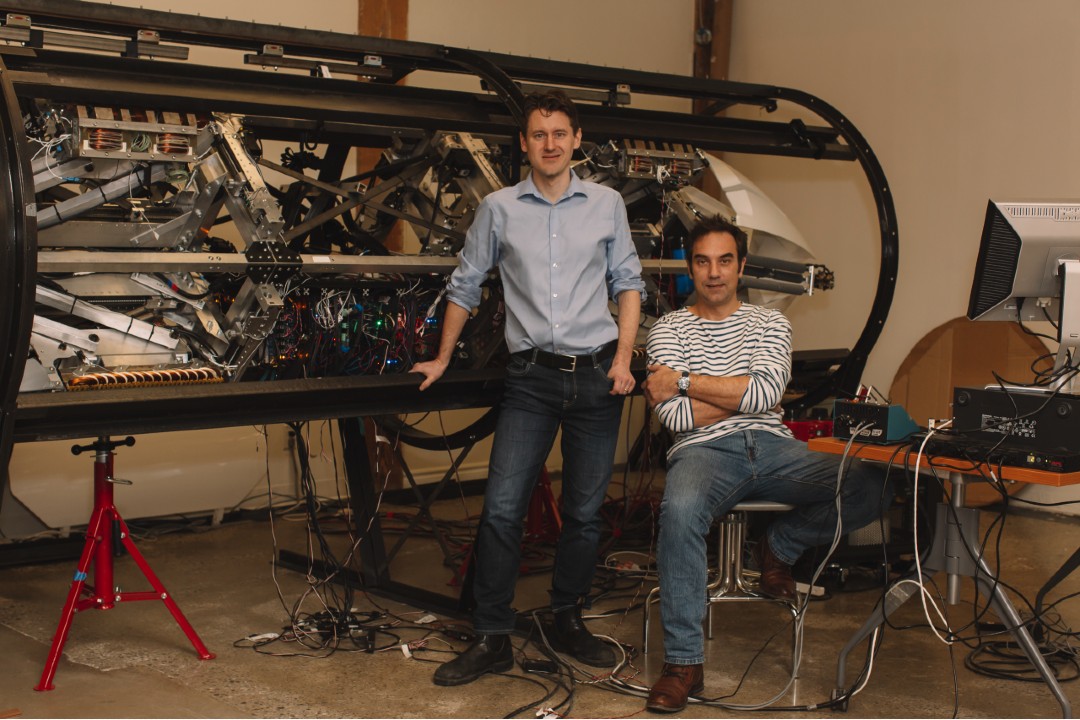The Toronto-based company that gained welcome from the provincial government in 2020 to test and build a hyperloop that would travel at 1,000 kilometres per hour between Edmonton and Calgary said it now hopes to construct a full-scale test guideway in Edmonton in 2026, after pausing for the province to complete its Passenger Rail Master Plan.
"We unveiled our first demonstrator (at one-third of the scale of the final version) two years ago, and we continue to work on it," Sebastien Gendron, the co-founder and CEO of TransPod, told Taproot. "There's actually a bigger one currently being designed, a half-scale one … In parallel, we'll also start, probably by the end of this year, the full-scale demonstrator."
In 2020, the provincial government and TransPod signed a memorandum of understanding. That memorandum committed the government to work to find the company suitable land to build a test guideway. In 2021, TransPod released a feasibility study that suggested its prototype FluxJet technology (which differs from the magnetic-levitation technology already used in China) could someday offer passengers a 45-minute trip between Alberta's two major cities. The study also suggested a hyperloop could create more than 140,000 jobs in Alberta and would cost around $22 billion.
Gendron told news media in 2023 that TransPod had stalled plans to conduct testing that year until Alberta's Railway Act recognized its technology, which would then allow it to secure land near the Edmonton International Airport.
Today, Gendron said TransPod has delayed building the testing guideway, and the investment and job creation it would mean, because the province has been working on the Passenger Rail Master Plan, which is due this summer and would potentially go into effect in the fall. "Because of the government stepping into this project (with the master plan for rail), we kind of paused a little bit to know where we're going with them," Gendron said. "Having said that, we already have the commitment from the Edmonton airport and the City of Edmonton to work with us."
Starting the prototype guideway from the Edmonton International Airport to the south side of the city will cost between $200,000 and $500,000, based on land acquisition and construction permits, Gendron said. He added that Sener, a Spanish engineering firm with experience in rail, aerospace, and data centres, estimates an infastructure cost of $1.8 million. He told CBC in February that the test alignment is agreed upon with the City of Edmonton but is also waiting on the province's rail plan. Gendron told Taproot that TransPod could begin construction on the test guideway, depending on the province's rail plan, by 2026.
Taproot asked the Ministry of Transportation and Economic Corridors for comment on the Passenger Rail Master Plan and TransPod, but did not receive a response. The province's webpage for passenger rail says the plan will examine connections between Edmonton, Calgary, the Rockies, and explore a Crown corporation "to develop the infrastructure, oversee daily operations, develop a fare collection/booking system, keep up with system maintenance, and plan for future system expansion." The page also says delivery of rail could be provided publicly, privately, or as a combination of the two.

Sebastien Gendron, the co-founder and CEO of TransPod (to the right of co-founder and CTO Ryan Janzen), said his company could spur an industrial ecosystem around a hyperloop-style transport system between Edmonton and Calgary. (Supplied)
In 2022, TransPod secured US$550 million. "From that investment (in the Edmonton-to-Calgary line), there's all the jobs we have to create and all the employment associated to (build and run the system)," Gendron said. "But it's more than that. The advantage we can bring compared to conventional technology, like high-speed trains, is the creation of the entire industrial ecosystem."
Gendron said the "industrial ecosystem" TransPod could help create could be similar to the aviation boom that made Montreal the third-largest aerospace centre in the world. He said the Edmonton-to-Calgary project would require a manufacturing facility in Alberta, and that it would source Canadian steel (which is now tariffed at 25% when entering the U.S..) As of March 28, Gendron was planning to reach out to two steel plants in Ontario "within the next few weeks" to present his company's plans for Alberta.
"Trump might be an opportunity … We'll see," he said. "There is an opportunity in Alberta to develop a major infrastructure project. Rather than selling your steel with stupid tariffs on it, you can keep it in Canada and have a pretty good market." Gendron added that TransPod would construct one tube for each direction of travel between Edmonton and Calgary, resulting in 600 kilometres worth of construction.
Gendron told CBC's Calgary Eyeopener in February that TransPod is seeking private investment over public funding. But he added to Taproot that government dollars are not off the table. "If the government doesn't want to invest, that's fine," Gendron said. "But if they want to invest, I mean, we're open to it. We're not going to be against it."
TransPod's FluxJet vehicles and their guideway tubes fall within hyperloop technology. Elon Musk introduced the term to the lexicon back in 2013, long before Musk began working closely with United States President Donald Trump. TransPod's FluxJet vehicles look vaguely like submarines, are fully electric, and are a mix of aircraft and train, with the vehicle hurtling through a sealed tube.
While no hyperloop-style train has launched in the 12 years since Musk introduced the concept, China has a test track that has earned some attention.
As far as proving the mode of transport is safe, Gendron said TransPod's tech would be validated by sending freight for about two years before passengers ride the rails. FedEx and DHL have both expressed interest in buying some of its FluxJet vehicles to run on the TransPod track, he added.
